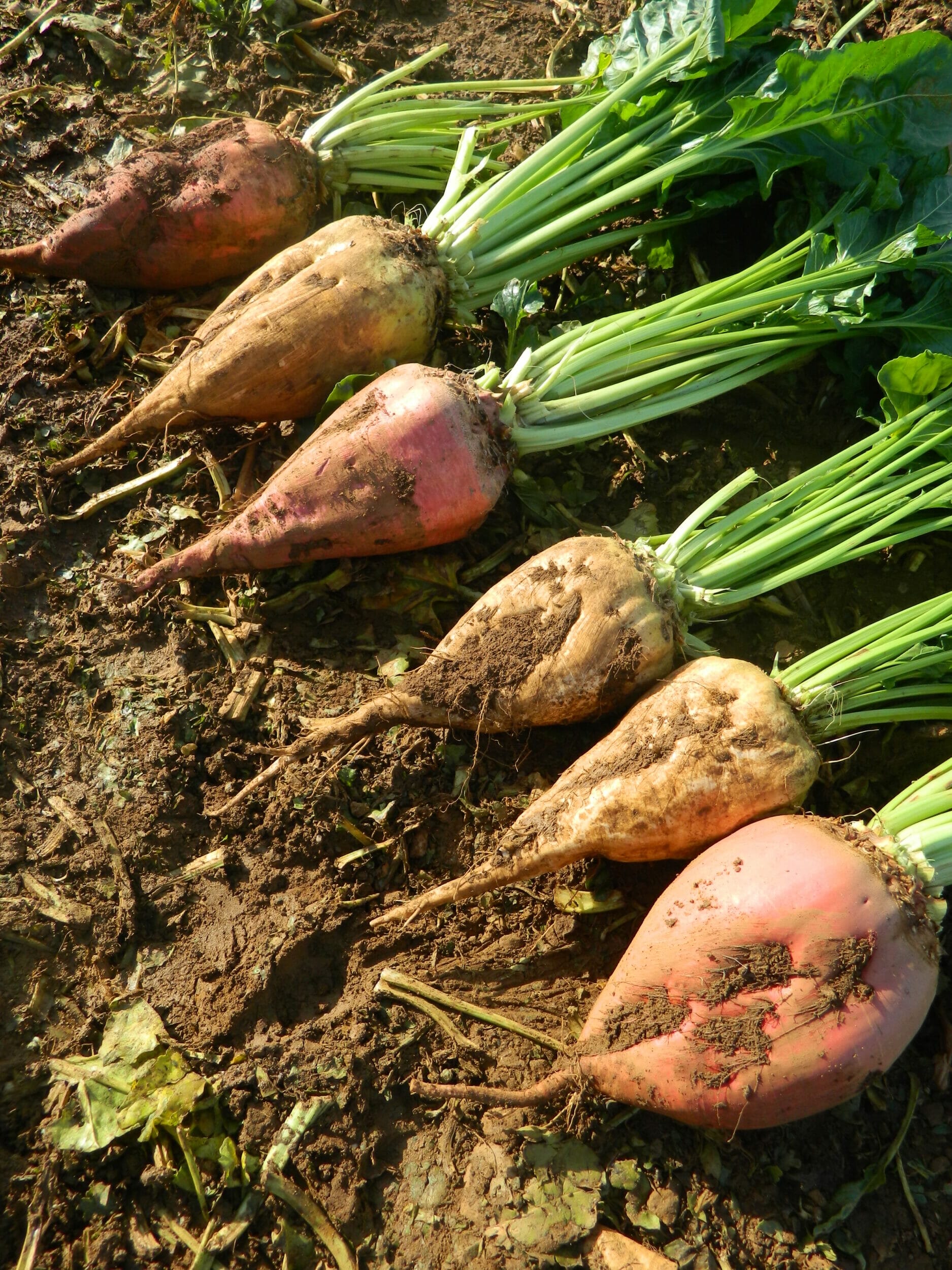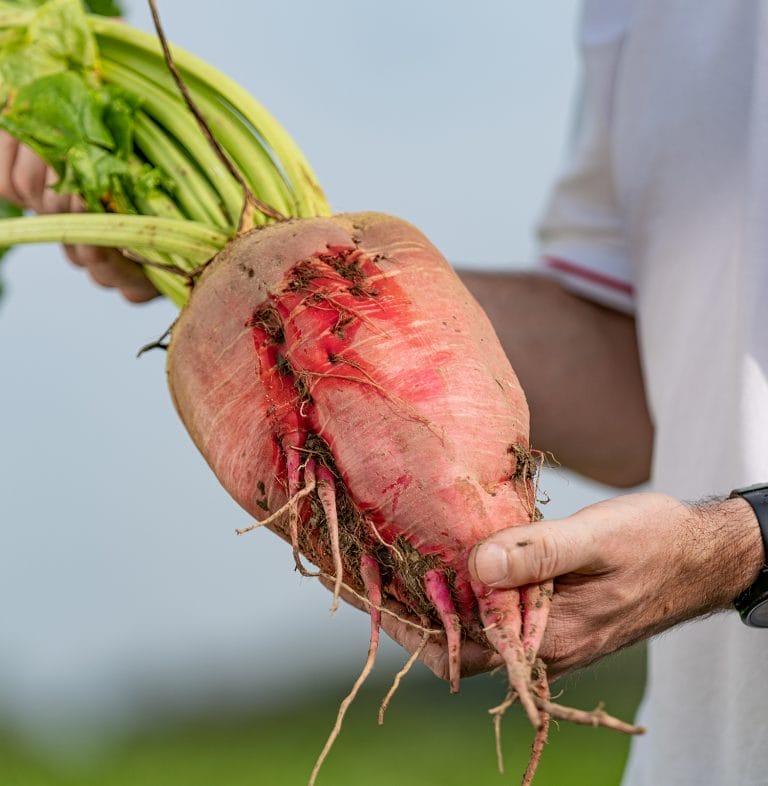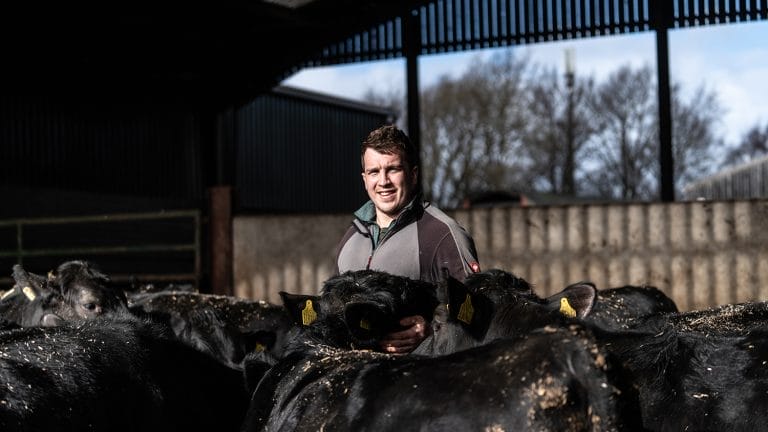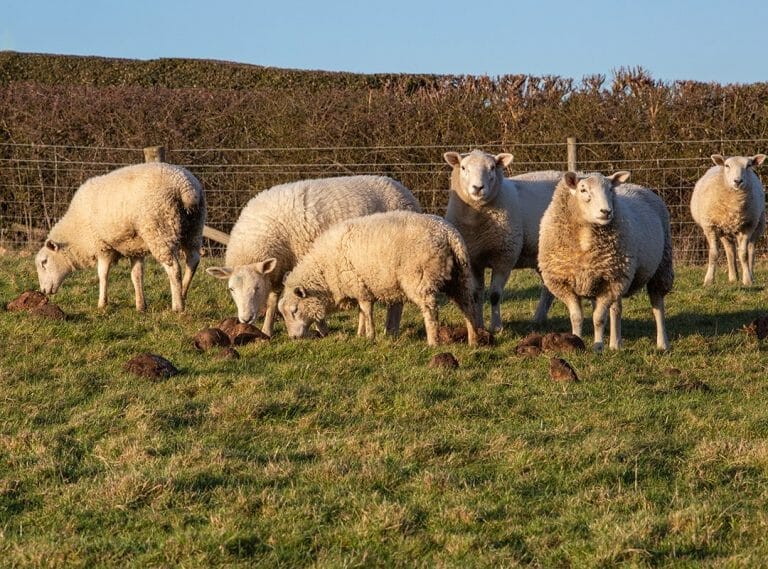New Zealand style system
Ed and Penny Friend run their 360 New Zealand Friesian cross Jersey milkers, plus 170 followers, on 200-hectare Bridgemere Farm, near Nantwich. This spring calving herd averages 5,300 litres of milk, at an impressive 4.97% butterfat and 3.83% protein. Milk is sold to Arla.
 Once calved, cows and heifers go out to graze, producing most of their milk from grass. But once dried off, a process that begins in November for the earliest calvers, cows and heifers strip graze fodder beet.
Once calved, cows and heifers go out to graze, producing most of their milk from grass. But once dried off, a process that begins in November for the earliest calvers, cows and heifers strip graze fodder beet.
The fodder beet suits Ed’s system – he’s grown the crop to overwinter dry cows and heifers for the past 10 years. “We introduced it when we switched to the New Zealand style system and began increasing cow numbers,” he explains.
“First it was about overwintering cattle outdoors, because we simply didn’t have the facilities to house them. But, once we got a few years in, we could see that they actually do better for being outside and grazing fodder beet.
“We don’t see lameness issues on the beet and body condition is good when the cows calve. The exercise seems to keep them fit and the thick, winter coats they develop are perfect for grazing in February. We’re really pleased with how it’s working and, even if we had the housing facilities, we’d still choose to overwinter our dry cows on fodder beet.”
Success with fodder beet
Success with fodder beet, as with any fodder crop, does take a certain mindset and some organisation, according to his agronomist Agrii’s Ross Dilks.
“But the returns are well worth the effort and I believe that more producers could reap the rewards of growing fodder crops to outwinter livestock – be that heifers or dry cows,” says Ross.
Timeliness when growing these crops is vital. “The work windows can be small, particularly when it comes to spraying with a herbicide. But a quick call to a contractor can sort that.”
Ed, who is also a fully qualified vet, says that is exactly what he does. He lets Ross keep an eye on the crop and literally ‘does as he’s told’. “If Ross calls and says that the crop needs to be sprayed in the next seven days, I get straight on the phone to the contractor,” he laughs.
Joking aside, he knows that if he follows this growing advice he’ll have a high-yielding, weed-free crop come late autumn. This will see his herd successfully through the winter and up until the point of calving.
Robbos fodder beet recommended
He’s grown Limagrain’s fodder beet variety Robbos for the past two years, admittedly on the recommendation of Ross, but he’s been pleased with the results.
“It suits our land, our system, and our cows. It’s not too deep rooted and has plenty of leafy top. It sits at just the right depth and the yields are good.”
Ed finds that the heifers will take the tops off first before investigating the roots, while the cows go straight for the bulbs and don’t waste anything.
 Choice of variety is important and needs to suit the system and land type. “Robbos is particularly popular with producers because the crown and root sit above the ground,” adds Ross. “First-time fodder beet growers like it as it’s a reliable and consistent performer and offers high dry matter yields.
Choice of variety is important and needs to suit the system and land type. “Robbos is particularly popular with producers because the crown and root sit above the ground,” adds Ross. “First-time fodder beet growers like it as it’s a reliable and consistent performer and offers high dry matter yields.
“It also offers some flexibility as the root, which is yellow, comes out of the ground very clean compared to some other varieties. It’s easy to harvest and can be stored and fed to housed stock, either whole or chopped. These are all considerations,” he adds.
Ed matches the area of fodder beet grown to his herd’s requirements. He’s now growing 12 hectares a year with two crops in succession, before a grass reseed. Fodder beet also offers a break in the rotation and, because it’s grazed, it also returns some organic matter and nutrients back to the soil.
Pre-drilling
Prior to drilling, he follows the plough with a dressing of chicken manure, from a neighbouring poultry unit. He also applies 400kg/ha of salt: “So the crop thinks it’s growing by the sea. It thrives in salty conditions,” he explains.
Ed also limes the soil before sowing, because the fodder beet prefers it slightly more alkaline than grass – pH 7 compared to pH 6.2.
“So there is a quite a bit of field work, but we know what works for us now and the benefits are well worth the extra time and effort.
Benefits worth the effort
“We’re not mucking out sheds or carting FYM come the spring. And there are no additional costs for housing, such as straw and labour for feeding and bedding up livestock. The benefits of outwintering on a home-grown forage crop can soon stack up, particularly if building space is at a premium.”
That said, Ed says that it is an investment and does require management. “It’s not an easy or cheap option and it has to be done well. That’s everything from drilling and growing the crop, through to measuring yield prior to grazing and then monitoring the crop and cow numbers to make sure it’s grazed efficiently.”
He goes out in September and estimates the yield, so he can put big baled grass silage out in the fields, before conditions get too wet for the loader. “We balance the fodder beet with silage throughout the winter and we have to get this right in the autumn as there’s no way we can get out there with additional bales come November.
 “We keep a close eye on the fodder beet from late summer and into autumn to see how it’s growing and maturing and weigh the crop in each individual field to estimate cow numbers required. We’re looking for around 18 tonnes of dry matter per hectare, but typically achieve more,” says Ed.
“We keep a close eye on the fodder beet from late summer and into autumn to see how it’s growing and maturing and weigh the crop in each individual field to estimate cow numbers required. We’re looking for around 18 tonnes of dry matter per hectare, but typically achieve more,” says Ed.
“The first group on the beet, in early November, is made up of the thinner February calvers plus all the in-calf heifers. Next are the earlier February calvers and the thin March calvers. And finally, at Christmas, we dry off the rest.
“But this is a flexible arrangement and we’ll move cows between groups, or dry more off if required, to keep up with the crop. The crop and the silage bales on offer are fixed but cow numbers can be more flexible.”
In January the cows that are due to calve first move to the beet field closest to the dairy and come in every day, via the parlour, to eat clamp silage instead of bales. “They can then be drafted into the calving yard as they bag up.”
He introduces the cows and heifers to fodder beet gradually, offering a smaller area and slightly more grass silage in early winter. “You have to give the rumen time to adjust to the fodder beet. The bugs are geared up for digesting grass and we have to watch the cows don’t eat too much beet when they’re first turned onto it. But the rumen bugs quickly adapt.” To avoid a drastic change to the ration after calving, Ed even adds a little bought-in beet to the transition ration in early lactation.
Enough to go around
He says that in the decade he’s been growing it, he’s never had a serious shortage. “Even if we have a slow start in the spring or drought in the summer, like the one we had in 2018, the crop quickly catches up after some rain and we’ve always had a good crop ready to grazed come early winter. And that’s essential and reassuring when you’re running a system like ours. We have a lot of dry cows to overwinter and we know that we can rely on fodder beet.”
There’s usually plenty of fodder beet – sometimes slightly too much in a good year. “But we’ve never run short and the milking cows can always ‘clean up’ – nothing goes to waste.”
He stresses that it’s all about monitoring and planning. Ten years of experience and help from other beet enthusiasts has made us better at it.”


































